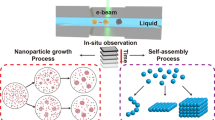Abstract
Porous films of tantalum (Ta) and its oxides exhibit numerous properties suitable for high surface area applications, mainly in the semiconductor and bio-implant industries. Such films can be developed by Ta nanoparticle deposition using DC magnetron sputtering with gas aggregation. In order to engineer films of desirable properties, accurate control and in-depth understanding of the processes and parameters of nanoparticle growth, deposition and coalescence are crucial. Of utmost importance is to control the film’s porosity, since it determines many of the other physical properties. To this end, we performed a number of classical Molecular Dynamics simulations to study the coalescence of two or more Ta nanoparticles. Temperature, relative size and crystallographic orientation, defect content, degree of crystallinity and deposition rate effects were taken into account, and a mapping of the sintering processes was acquired. A broad range of possible interaction mechanisms were observed, from simple nanoparticle reorientation in order to achieve epitaxial configuration, to atomic adsorption, neck formation, twinning within the nanoparticles and full consolidation into a single, larger nanoparticle. The parameters studied are directly linked to experimental deposition parameters; therefore, fitting them accordingly can lead to growth of films with bespoke properties.









Similar content being viewed by others
References
Bermudez MD, Francisco J, Carrion FJ, Nicolas GM, Lopez R (2005) Errosion–corrosion of stainless steels, titanium, tantalum and zirconium. Wear 258:693–700
Roy M, Balla VK, Bandyopadhyay A, Bose S (2012) MgO-doped tantalum coating in Ti: microstructural study and biocompatibility evaluation. ACS Appl Mater Interfaces 4:577–580
Bloor LG, Manzi J, Binions R, Parkin IP, Pugh D, Afonja A, Blackman CS, Sathasivam S, Carmalt CJ (2012) Tantalum and titanium doped In2O3 thin films by aerosol-assisted chemical vapour deposition and their gas sensing properties. Chem Mater 24:2864–2871
Bonitatibus PJ Jr, Torres AS, Kandapallil B, Lee BD, Goddard GD, Colborn RE, Marino ME (2012) Preclinical assessment of a zwitterionic tantalum oxide nanoparticle X-ray contrast agent. ACS Nano 06:6650–6658
Stella K, Burstel D, Franzka S, Posth O, Diesing D (2009) Preparation and properties of thin amorphous tantalum films formed by small e-beam evaporators. J Phys D 42:135417
Wang Y, Cui Z, Zhang Z (2004) Synthesis and phase structure of tantalum nanoparticles. Mater Lett 58:3017–3020
Park KY, Kim HJ, Suh YJ (2007) Preparation of tantalum nanopowders through hydrogen reduction of TaCl5 vapor. Powder Technol 172:144–148
Haberland H, Karrais M, Mall M, Thurner Y (1992) Thin films from energetic cluster impact: a feasibility study. J Vac Sci Technol A 10:3266–3271
Li Y, Zhang S, Guo L, Dong M, Liu B, Mamdouh W (2012) Collagen coated tantalum substrate for cell proliferation. Colloids Surf B 95:10–15
Matsuno H, Yokoyama A, Watari F, Uo M, Kawasaki T (2001) Biocompatibility and osteogenesis of refractory metal implants, titanium, hafnium, niobium, tantalum and rhenium. Biomaterials 22:1253–1262
Wheeldon I, Farhadi A, Bick AG, Jabbari E, Khademhosseini A (2011) Nanoscale tissue engineering: spatial control over cell-materials interactions. Nanotechnology 22:212001
Han Y, Zhou JH, Zhang L, Xu KW (2011) A multi-scaled hybrid orthopedic implant: bone ECM-shaped Sr-HA nanofibers on the microporous walls of a macroporous titanium scaffold. Nanotechnology 22:275603
Singh V, Cassidy C, Bohra M, Galea A, Hawash Z, Sowwan M (2013) Surface morphology of films grown by size-selected Ta nanoparticles. Adv Mater Res 647:732–737
Zhu H, Averback RS (1996) Sintering processes of two nanoparticles: a stydy by molecular dynamics simulations. Philos Mag Lett 73:27–33
Meinander K, Nordlund K (2009) Modeling of film growth by cluster deposition: the effect of size and energy. Phys Rev B 79:235435
Arcidiacono S, Bieri NR, Poulikakos D, Grigoropoulos CP (2004) On the coalescence of gold nanoparticles. Int J Multiphas Flow 30:979–994
Zhao SJ, Wang SQ, Yang ZQ, Ye HQ (2001) Coalescence of three silver nanoclusters: a molecular dynamics study. J Phys 13:8061–8069
Kart HH, Wang G, Karaman I, Çağin T (2009) Molecular dynamics study of the coalescence of equal and unequal sized Cu nanoparticles. Int J Mod Phys C 2:179–196
Lewis LJ, Jensen P, Barrat JL (1997) Melting, freezing, and coalescence of gold nanoclusters. Phys Rev B 56:2248–2257
Ding F, Rosén A, Bolton K (2004) Size dependence of the coalescence and melting or iron clusters: a molecular dynamics study. Phys Rev B 70:075416
Johnson KL, Kendall K, Roberts AD (1971) Surface energy and the contact of elastic solids. Proc R Soc A 324:301–313
Eggersdorfer ML, Kadau D, Herrmann HJ, Pratsinis SE (2012) Aggregate morphology evolution by sintering: number and diameter of primary particles. J Aerosol Sci 46:7–19
Gale JD (1997) GULP: a computer program for the symmetry-adapted simulation of solids. J Chem Soc Faraday Trans 93(4):629–637
Finnis MW, Sinclair JE (1984) A simple empirical N-body potential for transition metals. Phil Mag 50:45–55
Leach AR (2001) Molecular modelling: principles and applications, 2nd edn. Pearson Education Limited, Essex, pp 267–270
Gan Y (2009) Atomic and subnanometer resolution in ambient conditions by atomic force microscopy. Surf Sci Rep 64:99–121
Acknowledgements
The authors would like to acknowledge the contribution of Dr Abhijit Chatterjee for his valuable technical advice, and thank Mr Antony Galea and Dr Steven Aird for their comments and editing advice.
Author information
Authors and Affiliations
Corresponding author
Rights and permissions
About this article
Cite this article
Grammatikopoulos, P., Cassidy, C., Singh, V. et al. Coalescence behaviour of amorphous and crystalline tantalum nanoparticles: a molecular dynamics study. J Mater Sci 49, 3890–3897 (2014). https://doi.org/10.1007/s10853-013-7893-5
Received:
Accepted:
Published:
Issue Date:
DOI: https://doi.org/10.1007/s10853-013-7893-5




